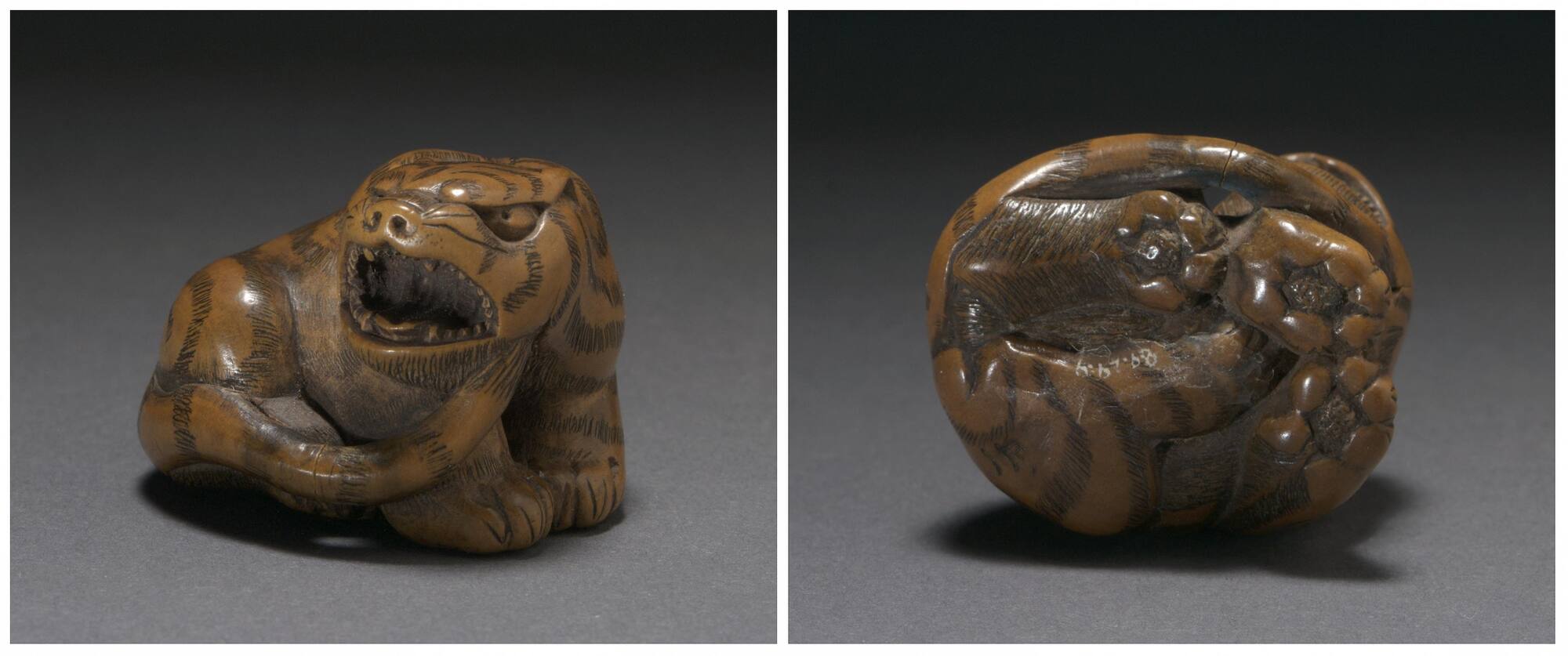
Object Details
Artist
Masakazu
Date
19th century
Medium
Carved boxwood (tsuge); Ink
Dimensions
1 x 1 3/8 inches (2.5 x 3.5 cm)
Credit Line
Gift of Drs. Lee and Connie Koppelman
Object
Number
89.029.009
BRIEF DESCRIPTIONThis is a wooden netsuke carved in the form of a snarling tiger.WHERE WAS IT MADE?T(…)
BRIEF DESCRIPTIONThis is a wooden netsuke carved in the form of a snarling tiger.WHERE WAS IT MADE?This netsuke was made in Japan.HOW WAS IT MADE?Netsuke made from wood, like this one, were hand-carved with knives, chisels and files of different sizes. On this netsuke, ink was used to darken the finely incised lines of patterning and detail.HOW WAS IT USED?During the Edo period (1603-1868), the standard attire for a well-dressed Japanese man consisted of a kimono tied with a sash. Because kimonos had no pockets, accessory bags and carrying cases (called sagemono: hanging things) were used to hold personal items such as money, medicines, tobacco and seals (a stamp carved with the owner’s name). Silken cords, attached to the sagemono, were threaded through the kimono sash (obi). A toggle, called a netsuke, was attached to the other end of the cord to prevent it from slipping through the sash. To see a netsuke with an inro—one popular type of sagemono that consisted of small, stacked compartments for holding medicines—search for object number 98.087.006 in the keyword search box.The term netsuke comes from the words “ne”, meaning ‘root’ and “tsuke”, meaning ‘to fasten.’ Early netsuke may have been made from found objects such as pieces of roots, nuts, coral and bone. Over time, netsuke production became more and more varied, refined, and innovative, reaching a high point in the early 19th century. Subjects and decoration of netsuke and sagemono reflected the tastes and aspirations of their owners, often infused with an element of comic irony. As clothing traditions modernized, netsuke came to be collected separately from sagemono, and appreciated as sculptural gems in their own right.WHY DOES IT LOOK LIKE THIS?The Chinese calendar follows a sixty-year cycle, broken into five twelve-year units. Each of the twelve years is associated with an animal. The day is also divided into twelve periods, each associated with one of the twelve animals. The animals associated with the year and the hour of one’s birth have long been used in some Asian countries to predict one’s character and personality traits. The animals of the zodiac became popular subjects for netsuke during the 19th century, as people became interested in purchasing netsuke depicting the animal associated with their birth year, as well as building collections of all twelve animals. The twelve animals are rat, ox, tiger, rabbit, dragon, snake, horse, goat, monkey, rooster, dog and pig. The tiger is a symbol of strength and power. In the zodiac, it is associated with qualities such as passion, daring, impulsiveness, and generosity. The tiger is also a companion to one of the Buddha’s disciples, known in Japan as Hattara Sonja. To see a painting of Hattara Sonja with a tiger in the Johnson Museum’s collection, search for object number 94.014.003 in the keyword search box. To compare this wooden netsuke of a tiger with one made from clay, also in the Johnson Museum’s collection, search for object number 87.048.064 in the keyword search box.












